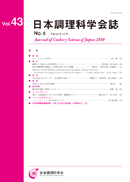Volume 43, Issue 1
Displaying 1-10 of 10 articles from this issue
- |<
- <
- 1
- >
- >|
Review
-
2010Volume 43Issue 1 Pages 1-9
Published: 2010
Released on J-STAGE: December 05, 2014
Download PDF (1499K)
Original paper
-
2010Volume 43Issue 1 Pages 10-16
Published: 2010
Released on J-STAGE: December 05, 2014
Download PDF (1556K) -
2010Volume 43Issue 1 Pages 17-23
Published: 2010
Released on J-STAGE: December 05, 2014
Download PDF (1632K)
Note
-
2010Volume 43Issue 1 Pages 24-30
Published: 2010
Released on J-STAGE: December 05, 2014
Download PDF (1612K)
Technical report
-
2010Volume 43Issue 1 Pages 31-37
Published: 2010
Released on J-STAGE: December 05, 2014
Download PDF (1989K) -
2010Volume 43Issue 1 Pages 38-43
Published: 2010
Released on J-STAGE: December 05, 2014
Download PDF (1415K)
Course text
-
2010Volume 43Issue 1 Pages 44-49
Published: 2010
Released on J-STAGE: December 05, 2014
Download PDF (4217K)
Educational materials research
-
2010Volume 43Issue 1 Pages 50-52
Published: 2010
Released on J-STAGE: December 05, 2014
Download PDF (1844K)
Cooking room
-
2010Volume 43Issue 1 Pages 53-55
Published: 2010
Released on J-STAGE: December 05, 2014
Download PDF (4012K)
Topics & opinion
-
2010Volume 43Issue 1 Pages 56
Published: 2010
Released on J-STAGE: December 05, 2014
Download PDF (1212K)
- |<
- <
- 1
- >
- >|
